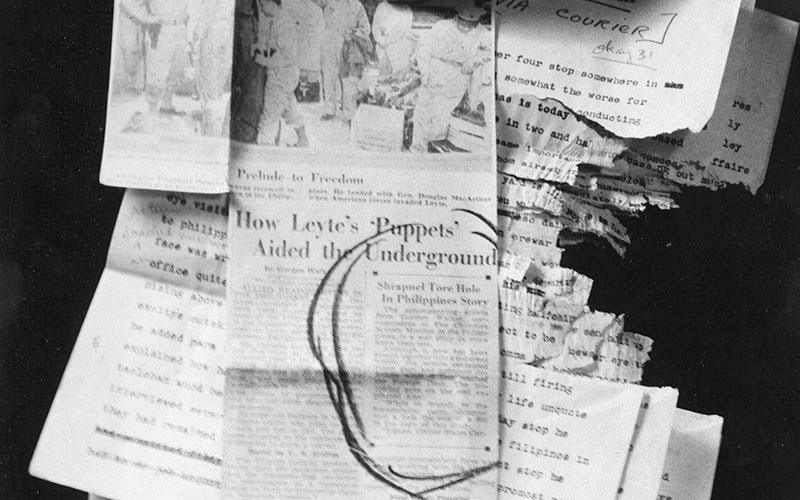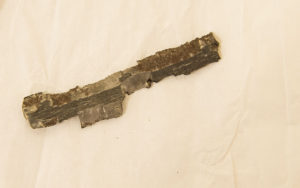“Adventures were inevitable”—the “Monitor” covers a war

Photo of damage caused by shrapnel, October 1944, Church Archives, Box 20224, Folder 127387.
On October 24, 1944, war correspondent Gordon Walker (1916–1959) wrote about the events of the day.1 While he had been sitting with a colleague in a second-story room, in an unnamed Philippine location, a Japanese bomb sent a piece of shrapnel through the wall.2 It missed both men but “tore a hole the size of a fist in this story.”3 Now housed in our archive, the offending shrapnel, along with the torn draft of Walker’s original article, serves as a reminder that more of his fascinating stories almost didn’t make it out of the Philippines.
Walker was a reporter for The Christian Science Monitor—one of Mary Baker Eddy’s most well-known initiatives. Throughout its history the newspaper has endeavored to provide readers with in-depth coverage of world events, sending staff around the globe. Erwin Canham was Editor during much of World War II and described the challenges that reporters including Walker (for whom he had great respect) faced:
Their job was to give an authentic picture of war and its meaning, not solely its adventures. And so, the adventures as such tended to be played down, the significance was emphasized…. But the adventures were inevitable, and many Monitor men had them.4
Part of the Library’s collections, Canham’s papers (where you’ll find that shrapnel and Walker’s draft article) illustrate the perils of such wartime “adventures.”
One of the most prominent reporters to cover World War II, Walker began his career with the Monitor in 1933 as a copy clerk. He joined the Christian Science church that same year and remained a member until his death. He was sent to join General Douglas MacArthur’s campaign in the Pacific Theatre in 1942, as a war correspondent.5 During this time he traveled alongside U.S. Marines, trekking through swamps and jungles and avoiding sniper fire, all the while carrying his portable typewriter. Walker later became one of the first Americans to set foot in Tokyo after the Japanese surrender. The marines who fought alongside him gained such respect for him that they elected him an honorary member of the Fourth Marine Raider Battalion.6 His election as an honorary marine speaks to his willingness to face ugly human situations with remarkable poise.
Some of the most dramatic evidence of the perils war correspondents faced came in Walker’s reporting from Allied Headquarters in the Philippines, toward the end of the war. On October 31, 1944, the Monitor published his article about aid the Philippine underground provided to American forces and their community. He highlighted several individuals who played dual roles—they worked for the Japanese-sponsored government and at the same time helped the underground. One doctor treated Japanese soldiers while smuggling supplies to Filipinos suffering malnutrition. Another local journalist produced a propaganda paper for the Japanese while also working on an underground freedom paper.7

Photo of a piece of shrapnel, 1944, Church Archives, Box 20224, Folder 127387.
Walker faced remarkable challenges. Nevertheless, as Canham noted, “[his] battlefront copy…was often written graphically but without affectation or exaggeration. It gained its power from the deeply exciting events it was describing.”8 Through this straightforward style and insightful reporting, he continued to enhance the Monitor’s reputation for years to come.
- Archivist’s estimate. The original letter is dated November 24. However, the text of the letter and reporting in the Monitor indicate that the actual date was October 24.
- Gordon Walker to Charles Gratke, undated, Church Archives, Box 20224, Folder 127387.
- “Shrapnel Tore Hole in Philippines Story,” The Christian Science Monitor, October 31, 1944.
- Erwin D. Canham, Commitment to Freedom: The Story of The Christian Science Monitor (Boston: Houghton Mifflin Company, 1958), 303.
- “Gordon Walker,” The Christian Science Monitor, June 1, 1959.
- Canham, Commitment to Freedom, 307–308.
- Gordon Walker, “How Leyte’s ‘Puppets’ Aided the Underground,” The Christian Science Monitor, October 31, 1944.
- ibid., 308.

